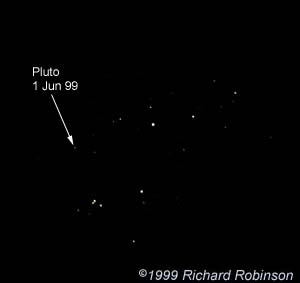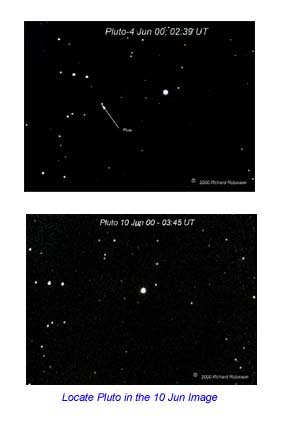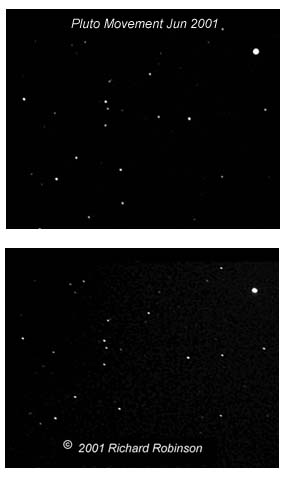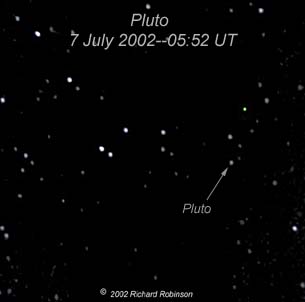 |
Scope: 8" LX 200 SCT |
| MX - 5C CCD | |
|
This
image of Pluto was taken on 1 Jun 99 at about 5hrs UT.
|
Focal Ratio: f4 |
| Exposure: 120 sec | |
 |
Scope: 8" LX 200 SCT |
| MX - 5C CCD | |
| Focal Ratio: f4 | |
| Exposure: 1 20 sec | |
| These two images show the movement of Pluto over a 10 day period during Aug 99. High clouds were present when the second image was taken, so fewer background stars are shown. The top image shows stars dimmer than magnitude 15.3. | |
 These two images show Pluto's movement in Jun 00. It was the first time I had imaged Pluto during the year 2000, and the first time I had used the STAR 2000 Auto tracker to image Pluto. I've marked the position of Pluto in the top image. See if you can find it in the lower image. Click here for the answer. |
Scope: 8" LX 200 SCT |
| MX - 5C CCD & STAR 2000 Auto Tracker | |
| Focal Ratio: f4 | |
| Exposure: 5 min | |
 Pluto is really moving fast towards the west. About 1.5 arcmin per day, so in 11 days between this photo and the 10 Jun photo, the star background has changed completely. |
Scope: 8" LX 200 SCT |
| MX - 5C CCD & STAR 2000 | |
| Focal Ratio: f4 | |
| Exposure: 5 min | |
 First images of 2001. Click here for animation. |
Scope: 8" LX 200 SCT |
| MX - 5C CCD & STAR 2000 | |
| Focal Ratio: f6.6 | |
| Exposure: 5 min | |

First image of the 2002 viewing season. |
Scope: 8" LX 200 SCT |
| MX - 5C CCD, STAR 2000 & IDAS LPR | |
| Focal Ratio: f4.8 | |
| Exposure: 5 min | |
| Click Here to visit the NASA New Horizon Mission to Pluto. |
 |
|
|
|